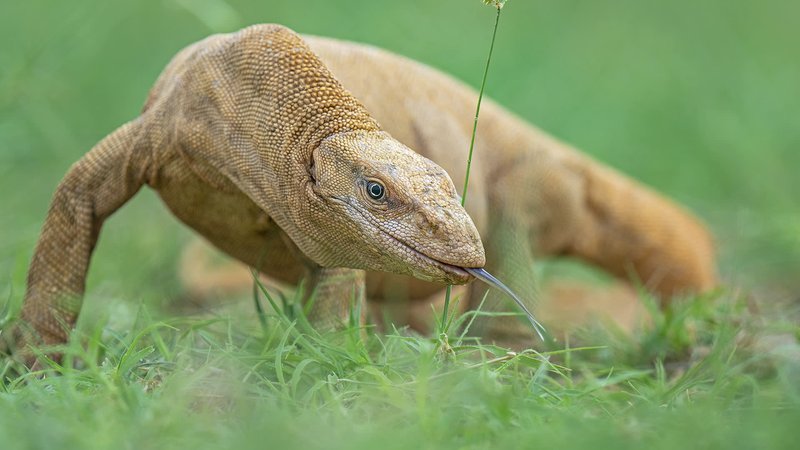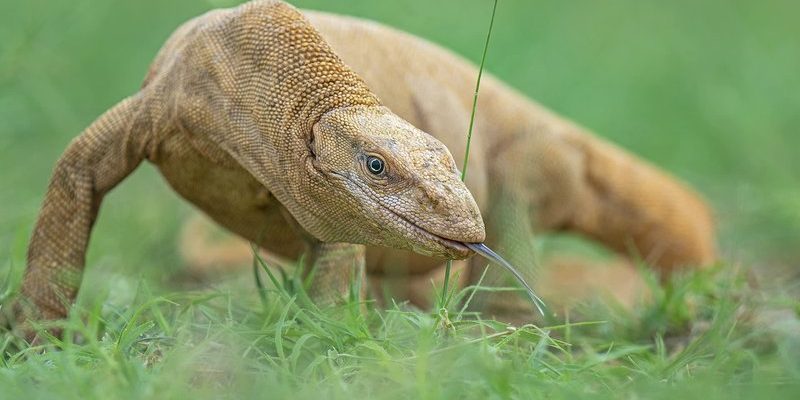
You might be wondering, what exactly makes monitor lizards stand out? Well, they’re packed with unique traits and behaviors that make them not just interesting but also important in their ecosystems. From their hunting techniques to their intelligence, get ready to learn about these remarkable creatures that roam the Earth!
1. They Come in Many Sizes
Monitor lizards are incredibly diverse. Ranging in size from the petite Dumeril’s monitor, which can be as small as 2 feet long, to the massive Komodo dragon, which can grow up to 10 feet, they really run the gamut. It’s like having a family of cousins where one is a small, quirky artist, and the other is a towering athlete!
The Komodo dragon, in particular, is known for its size and power. It’s the largest lizard on the planet and roams the islands of Indonesia. These powerful creatures are often a focal point in discussions about monitor lizards because they not only command respect in size but also in hunting skills.
Even the smaller monitors have fascinating adaptations. For instance, the Nile monitor has powerful limbs and sharp claws, allowing it to climb trees and dig burrows with ease. Each species has its own set of tools, making them well-adapted to their environments.
2. They’re Highly Intelligent
Here’s the thing: monitor lizards are often smarter than you’d expect. They have a keen ability to learn and adapt, demonstrating a level of intelligence that rivals some pets. You might be surprised to know that they can recognize their owners and even respond to certain cues.
Think about a dog or cat. They learn tricks and commands over time, and monitor lizards can do something similar! Training a monitor lizard might take some time and patience, but with consistency, they can learn to engage with their environment and even perform simple tasks.
Their intelligence doesn’t just stop at learning commands. Monitor lizards are known to use tools in the wild, like using sticks to poke at prey or even manipulate their environment to reach food. This shows that they are not just instinct-driven; they think critically—a trait that’s rare in reptiles.
3. They Have Unique Hunting Skills
When it comes to hunting, monitor lizards are impressive predators. Equipped with sharp claws, strong jaws, and a keen sense of smell, they are skilled at tracking down their next meal. You might be surprised to learn they can detect odors from more than a mile away!
Monitor lizards are carnivorous, which means they eat meat. Their diet mainly consists of insects, small mammals, and even birds. Some larger species, like the Komodo dragon, have been known to take down larger prey, including deer. Their hunting strategy often involves stealth and speed.
Once they’ve located their prey, they can sprint surprisingly fast, using their powerful legs. They often mimic the movements of their prey to get closer without being noticed. When they strike, it’s both swift and calculated—a true testament to their predatory prowess.
4. They Have Fascinating Defense Mechanisms
Just like any animal, monitor lizards have to protect themselves from threats. So, how do they do it? Well, their first line of defense is often their size and strength. Many monitor lizards are robust and can hold their own against smaller predators.
However, size isn’t their only defense. When a monitor lizard feels threatened, it can display aggressive behaviors, like hissing and lunging. Some species even have venomous bites, although it’s not dangerous to humans.
For some, camouflage plays a critical role in their survival. Many monitor lizards blend into their surroundings, making it hard for predators to spot them. It’s like wearing the best invisible cloak without the need for special powers!
5. Their Social Behavior is Intriguing
You might picture monitor lizards as solitary creatures, but they can display some fascinating social behaviors. While many species prefer to go solo, some, like the Nile monitor, can be quite social, especially during mating season.
In these interactions, they communicate through body language, vocalizations, and even scent marking. You may notice them engaging in head-bobbing displays to establish dominance over one another. It’s almost like a dance-off among cousins at a family gathering!
When it comes to mating, males will often engage in wrestling matches to assert their strength and attract a mate. It’s not just about who’s the biggest; it’s a show of skill and agility.
6. They’re Found in Various Habitats
Monitor lizards are adaptable creatures. You can find them in a wide range of habitats, from tropical forests to grasslands and even deserts. It’s like they have a knack for fitting in wherever they go!
In tropical areas, monitor lizards thrive in lush environments where they can climb trees and hide in foliage. The Komodo dragon, however, prefers the arid heat of Indonesian islands, demonstrating their ability to adapt to even the most challenging environments.
They play important roles in their ecosystems, acting as both predators and prey. By controlling populations of smaller animals, they help maintain a balance in their habitat. In turn, they, too, provide food for larger predators, illustrating the interconnectedness of nature.
7. Some Are Great Swimmers
Have you ever seen a lizard swim? Monitor lizards are actually excellent swimmers! They have long, powerful tails that help them navigate through water with ease. It’s almost like watching a small crocodile glide through the water.
This ability to swim helps them hunt for food in aquatic environments, like rivers and lakes. Monitor lizards will often dive underwater to catch fish or escape from predators. Their swimming skills set them apart from many other lizard species, who may avoid water altogether.
So, if you’re ever near a body of water and spot a monitor lizard, don’t be surprised if it takes a dip. They’re as comfortable in the water as they are on land, showcasing their versatility as a species.
8. They Can Live a Long Time
It’s pretty mind-blowing to think that monitor lizards can live quite a long time, especially in captivity. Some species can live up to 30 years with proper care. That’s a lot of birthdays to remember!
In the wild, their lifespan can be shorter due to natural threats, but you’ll often find that captive monitor lizards thrive in controlled environments. Owners who provide the right diet, habitat, and care can enjoy the companionship of these remarkable lizards for decades.
This longevity makes them a great choice for dedicated reptile enthusiasts. Just like any long-term commitment, owning a monitor lizard requires responsibility and attention to their specific needs.
9. They Face Conservation Challenges
Unfortunately, not everything is rosy for monitor lizards. Many species are facing threats due to habitat destruction, hunting, and illegal trade. It’s a tough reality that puts these amazing creatures at risk.
Conservation efforts are essential to protect their habitats and ensure they continue to thrive. Organizations are working to raise awareness and create safe zones for these reptiles. It’s like having a community rally to support a family member in need.
As individuals, we can help by supporting conservation initiatives or educating others about these fascinating lizards. Every little bit counts when it comes to preserving their existence.
10. They Make Unique Pets
If you’re considering a monitor lizard as a pet, there are a few things to keep in mind. They can be charming companions, but they come with unique challenges. For instance, they require a spacious habitat and specialized care.
Monitor lizards are not like typical household pets; they need plenty of space to roam and explore. Setting up a proper enclosure is crucial, as it mimics their natural environment. You’ll want to provide climbing structures, heat sources, and hiding spots.
Regular interaction is key to building a bond with your monitor lizard. Just like any pet, they thrive on attention and engagement. With the right approach, you’ll find that they can be fascinating and rewarding companions.
In conclusion, monitor lizards are extraordinary creatures that deserve our admiration. From their intelligence to their unique adaptations, they are a reminder of the wonder of nature. Let’s continue to learn about and protect these fascinating reptiles for generations to come!

